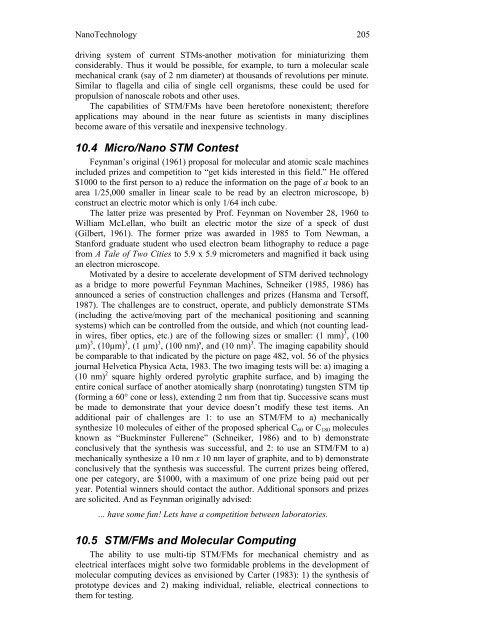ULTIMATE COMPUTING - Quantum Consciousness Studies
ULTIMATE COMPUTING - Quantum Consciousness Studies
ULTIMATE COMPUTING - Quantum Consciousness Studies
- No tags were found...
You also want an ePaper? Increase the reach of your titles
YUMPU automatically turns print PDFs into web optimized ePapers that Google loves.
NanoTechnology 205<br />
driving system of current STMs-another motivation for miniaturizing them<br />
considerably. Thus it would be possible, for example, to turn a molecular scale<br />
mechanical crank (say of 2 nm diameter) at thousands of revolutions per minute.<br />
Similar to flagella and cilia of single cell organisms, these could be used for<br />
propulsion of nanoscale robots and other uses.<br />
The capabilities of STM/FMs have been heretofore nonexistent; therefore<br />
applications may abound in the near future as scientists in many disciplines<br />
become aware of this versatile and inexpensive technology.<br />
10.4 Micro/Nano STM Contest<br />
Feynman’s original (1961) proposal for molecular and atomic scale machines<br />
included prizes and competition to “get kids interested in this field.” He offered<br />
$1000 to the first person to a) reduce the information on the page of a book to an<br />
area 1/25,000 smaller in linear scale to be read by an electron microscope, b)<br />
construct an electric motor which is only 1/64 inch cube.<br />
The latter prize was presented by Prof. Feynman on November 28, 1960 to<br />
William McLellan, who built an electric motor the size of a speck of dust<br />
(Gilbert, 1961). The former prize was awarded in 1985 to Tom Newman, a<br />
Stanford graduate student who used electron beam lithography to reduce a page<br />
from A Tale of Two Cities to 5.9 x 5.9 micrometers and magnified it back using<br />
an electron microscope.<br />
Motivated by a desire to accelerate development of STM derived technology<br />
as a bridge to more powerful Feynman Machines, Schneiker (1985, 1986) has<br />
announced a series of construction challenges and prizes (Hansma and Tersoff,<br />
1987). The challenges are to construct, operate, and publicly demonstrate STMs<br />
(including the active/moving part of the mechanical positioning and scanning<br />
systems) which can be controlled from the outside, and which (not counting leadin<br />
wires, fiber optics, etc.) are of the following sizes or smaller: (1 mm) 3 , (100<br />
µm) 3 , (10µm) 3 , (1 µm) 3 , (100 nm) s , and (10 nm) 3 . The imaging capability should<br />
be comparable to that indicated by the picture on page 482, vol. 56 of the physics<br />
journal Helvetica Physica Acta, 1983. The two imaging tests will be: a) imaging a<br />
(10 nm) 2 square highly ordered pyrolytic graphite surface, and b) imaging the<br />
entire conical surface of another atomically sharp (nonrotating) tungsten STM tip<br />
(forming a 60° cone or less), extending 2 nm from that tip. Successive scans must<br />
be made to demonstrate that your device doesn’t modify these test items. An<br />
additional pair of challenges are 1: to use an STM/FM to a) mechanically<br />
synthesize 10 molecules of either of the proposed spherical C 60 or C 180 molecules<br />
known as “Buckminster Fullerene” (Schneiker, 1986) and to b) demonstrate<br />
conclusively that the synthesis was successful, and 2: to use an STM/FM to a)<br />
mechanically synthesize a 10 nm x 10 nm layer of graphite, and to b) demonstrate<br />
conclusively that the synthesis was successful. The current prizes being offered,<br />
one per category, are $1000, with a maximum of one prize being paid out per<br />
year. Potential winners should contact the author. Additional sponsors and prizes<br />
are solicited. And as Feynman originally advised:<br />
... have some fun! Lets have a competition between laboratories.<br />
10.5 STM/FMs and Molecular Computing<br />
The ability to use multi-tip STM/FMs for mechanical chemistry and as<br />
electrical interfaces might solve two formidable problems in the development of<br />
molecular computing devices as envisioned by Carter (1983): 1) the synthesis of<br />
prototype devices and 2) making individual, reliable, electrical connections to<br />
them for testing.






